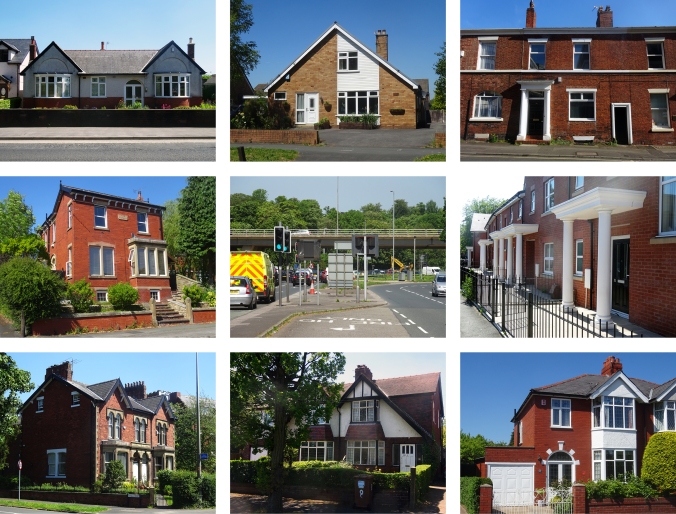
Writer and artist Lauren Velvick reports on an artists’ meeting for The Expanded City project…
Having previously considered the city specifically in terms of its edges and boundaries, for the forthcoming critical exploration of Preston’s ongoing development, In Certain Places has proposed connection as the kernel around which this year’s programme will develop. For the participating artists, connection functions as a springboard for works and processes that range from the topographical to the digital. In an initial discussion, Ruth Levene and Ian Nesbitt, Emily Speed, Olivia Keith and Gavin Renshaw were joined by Ehab Kamel Ahmed, a UCLan lecturer who is investigating the potential for digitally mapping cultural history. Ehab described his plan to develop software with an interface similar to that of familiar GPS devices and apps, but that would allow the layering of different sorts of data. In comparison with the project’s previous stage, this constitutes a digital and collaborative version of deep mapping, rather than one that stems from individual experience, drawing and writing. Ehab’s work is especially relevant to those of the artists who have been concerned with mapping as a process, which was described by Olivia as “making tangible what is precious”.
Within the ongoing research conducted by Ruth and Ian, Gavin and Olivia, there has been an evident push and pull between a desire to legitimise their routes and findings through a process of mapping and misgivings about the way that mapping formalises knowledge. This issue was confronted by Ruth and Ian when all of the artists reconvened with In Certain Places, and they introduced forms of categorisation that are wilfully experimental, rather than functional. Ruth and Ian have also reiterated their critique of ‘the superhighway’, which could be a road or a footpath, but one that overwhelms and replaces existing pathways. The action of amalgamating all routes into a single way serves an ideological as well as an infrastructural function, effectively eradicating the possibility of being led by the land itself. This critique is also present within Gavin’s research, but is complicated by the issues around safety for cyclists; it is an unfortunate truth that using unfamiliar roads and pathways that are shared with motorists can be dangerous. This means that superhighways like Preston’s Guild Wheel are necessary in order for people to enjoy cycling in the city without fear, and there is an urgent need for clear, safe and known routes out of the city centre.
Alongside these concerns, Gavin has also made reference to the individual and personal maps that evolve automatically in the use of an environment, but has now become interested in the possibility of somehow influencing the city as it is developed over the coming years. Having Ehab present at this meeting was helpful when the discussion circled repeatedly back to the dichotomy between official and vernacular mapping, introducing the possibility of a multi-layered digital map that could hold a great deal more information than a paper illustration. In practice, this could mean that somebody moving into a newly built house would be able to easily and even offhandedly discover elements of cultural and social local history, and can be likened to the way that parentheses and footnotes function in writing, allowing for peripheral information to be embedded within the official text.
The practical importance of this register of knowledge comes to the fore when Emily is describing her plan for topographical alterations, and Olivia notes that: “If you dig deep enough in that area, you’ll find water.” Whilst the reconfiguration of the city is a concern for Emily, as for the rest of the artists, she is exploring it in micro whilst the other artists are taking a macro view of the city as whole, or at least area by area. The inorganic growth of housing clusters, dictated by the market rather than any pattern or design, manifests in a minimum of green space (described by Emily as pocket parks) and seemingly little thought given to the use of these new spaces. In line with her wider concerns around how the individual human body interacts with, and reacts to, architecture and environment, in this context Emily is planning to explore how the action of digging and of breaking ground can manifest as a visceral and elemental form of play.
By taking part in this project we have each been encouraged to anticipate the future of the city, with some projects seeking to influence and others to subvert or simply record. In this next stage, it feels rather more urgent to either have an effect on the status quo or offer up an alternative, and in terms of my own research this has led to a consideration of unacknowledged realities. Casting back to the Expanded City symposium last year, the assumption that new dwellings will be occupied by individuals, couples or nuclear families becomes increasingly far-fetched as multigenerational, and communal, forms of household necessarily proliferate. It seems that for each of us there had been a hope of surety where there is only shrugging, and for answers where there are none to be had, so we are now formulating our own answers to the questions raised last year.